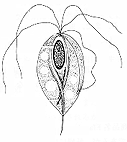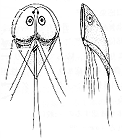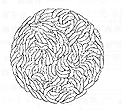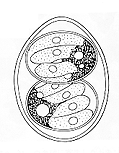The protozoan parasites are very common in tortoises. Some people say that many protozoan parasites
are non-pathogenic, but it is not always so . Most protozoans have direct life cycles and thus can build up
in captivity, and in this circumstance it can be harmful. As with all parasites with direct life cycles,
to keep the environment clean and in good hygiene is essential to their control.
Keeping tortoises in too much high temperature overnights is also the main cause of its proliferation.
Feeding a diet rich in protein and sugar such as beans, peas, and fruits, will also cause its proliferation.
There are some Amebiasia which can infect with tortoises. One of the most important protozoan parasite
in tortoises is said to be Entamoeba invadens, which can be extremely pathogenic. It is said that formerly,
a large number of leopard tortoises imported into Japan via East-west Asia, had died of amoebic dysentery.
It is acquired by eating or drinking fecally contaminated food and water, and also by the contaminated
environment. Amebiasia are infective in the cysts stage.
One thing to note is that there are many animals that seldom become affected or die by this infection, but that
these animals can serve as carriers. For example, garter snakes, and box turtles. While most turtles are resistant
to this parasite, the giant tortoises are known to be very susceptible.
But it is not so common to tortoises in captivity. The clinical symrtoms are variable, but in the case of amoebic
dysentery anorexia, wasting, dehydration, and death can occur. The infected animals are usually anorectic and
often pass mucus-laden, bile-stained, and sometimes bloody stools.
To diagnose the Entamoeba by microscope examination, find the amoeba, uni-nucleated trophozoites,
or multi-nucleated cysts in smears of fresh stools.
The drug of choice is Flagyl (metronidazole), at 25 - 50 mg/kg, given orally once every two weeks until
negative fecal examinations are made.
This dose rate is just a reference data. Please consult your vet before dosing.
We recomend changing bedding frequently. And remove feces promptly, and observe proper hygiene.
TO TOP OF THE PAGE
 There are numerous species of flagellates and their pathogenicity is questioned. These protozoans (Hexamita, Trichomonas, etc.) are commonly found in the gastrointestinal tract of tortoises. There is controversy over whether these are normal intestinal flora or true pathogens. (The Drawing is a Trichomonas.)
There are numerous species of flagellates and their pathogenicity is questioned. These protozoans (Hexamita, Trichomonas, etc.) are commonly found in the gastrointestinal tract of tortoises. There is controversy over whether these are normal intestinal flora or true pathogens. (The Drawing is a Trichomonas.)
 (The Drawing is Giardia lamblia Stiles.)
The flagellates are acquired by being exposed to infective cysts in the contaminated food or water,
or it can also be acquired during copulation. Symptoms are variable. Small numbers of flagellates can be
considered to be a normal intestinal flora. However, if the tortoise is infected by a large number of flagellates,
symptoms such as diarrhea, mucous or blood in stools, anorexia, etc, should occur.
(The Drawing is Giardia lamblia Stiles.)
The flagellates are acquired by being exposed to infective cysts in the contaminated food or water,
or it can also be acquired during copulation. Symptoms are variable. Small numbers of flagellates can be
considered to be a normal intestinal flora. However, if the tortoise is infected by a large number of flagellates,
symptoms such as diarrhea, mucous or blood in stools, anorexia, etc, should occur.
One of the highly pathogenic flagellets is the Hexamita. In the case of Hexamitiasis, the urinary and renal system
may be attacted, and thus the urine can be thickened and smells very strong (like ammonia). If you leave animals
with such symptoms untreated, it may lead to a severe kidney damage. In any case you find such symptoms,
never ignore them and consult your vet as soon as possible!
 (The Drawing is the Trypanosomatina trypomastigote stage.)
Diagnosis can be made on direct smears. More practice and expertise with a microscope is needed to
accurately diagnose these parasites. Staining with a solution such as Giemsa's stein solution (an Azur - Eosin -
Methylene blue Solution) will help you to highlight these organisms for easier viewing.
(The Drawing is the Trypanosomatina trypomastigote stage.)
Diagnosis can be made on direct smears. More practice and expertise with a microscope is needed to
accurately diagnose these parasites. Staining with a solution such as Giemsa's stein solution (an Azur - Eosin -
Methylene blue Solution) will help you to highlight these organisms for easier viewing.
Treat with Flagyl (metronidazole) orally, at 25 - 150 mg/kg for three to four days.
This dose rate is just a reference data. Please consult your vet before dosing.
TO TOP OF THE PAGE
 Coccidia(coccidium) is one of the families of Sporozoa. Within coccidium, there are many genus and species. For example Eimeria, Isospora, Toxoplasma, Caryospora, Cryptosporidium sp. These parasites are generally acquired by exposure to fecally-contaminated food, water, and the environment such as the cases of other protozoans.(The Drawing is a Toxoplasma tachyzoite.)
Coccidia(coccidium) is one of the families of Sporozoa. Within coccidium, there are many genus and species. For example Eimeria, Isospora, Toxoplasma, Caryospora, Cryptosporidium sp. These parasites are generally acquired by exposure to fecally-contaminated food, water, and the environment such as the cases of other protozoans.(The Drawing is a Toxoplasma tachyzoite.)
 (The Drawing is cyst.)
(The Drawing is cyst.)
Coccidia, like most of the protozoans, rarely cause problems in wild animals. Coccidia is a parasite with a direct life cycle, and can build up in captivity and is aided by stress, poor hygiene, and so on..., of its host.
Symptoms are very variable. Some tortoises may feed well but have mild diarrhea, and others may be afflicted
with severe diarrhea, anorexia, debilitation, and eventual death. There are also animals that shows no symptoms
but do serve as a carrier.
To diagnose Coccidia with a microscope examination, you shouls find oocysts on direct fecal smears or
fecal floats of fresh stools.
 (The drawing is Oocyst.)
(The drawing is Oocyst.)
Treatment consists of orally administering sulfadimethoxine at a dosage of 50 mg/kg daily for three days, stopping three days, then repeating the dosage for three more days. This dose rate is just a reference data. Please consult your vet before dosing. Of course, you have to clean up the environment hygienically.
TO TOP OF THE PAGE
 There are numerous species of flagellates and their pathogenicity is questioned. These protozoans (Hexamita, Trichomonas, etc.) are commonly found in the gastrointestinal tract of tortoises. There is controversy over whether these are normal intestinal flora or true pathogens. (The Drawing is a Trichomonas.)
There are numerous species of flagellates and their pathogenicity is questioned. These protozoans (Hexamita, Trichomonas, etc.) are commonly found in the gastrointestinal tract of tortoises. There is controversy over whether these are normal intestinal flora or true pathogens. (The Drawing is a Trichomonas.)
 (The Drawing is Giardia lamblia Stiles.)
The flagellates are acquired by being exposed to infective cysts in the contaminated food or water,
or it can also be acquired during copulation. Symptoms are variable. Small numbers of flagellates can be
considered to be a normal intestinal flora. However, if the tortoise is infected by a large number of flagellates,
symptoms such as diarrhea, mucous or blood in stools, anorexia, etc, should occur.
(The Drawing is Giardia lamblia Stiles.)
The flagellates are acquired by being exposed to infective cysts in the contaminated food or water,
or it can also be acquired during copulation. Symptoms are variable. Small numbers of flagellates can be
considered to be a normal intestinal flora. However, if the tortoise is infected by a large number of flagellates,
symptoms such as diarrhea, mucous or blood in stools, anorexia, etc, should occur. (The Drawing is the Trypanosomatina trypomastigote stage.)
Diagnosis can be made on direct smears. More practice and expertise with a microscope is needed to
accurately diagnose these parasites. Staining with a solution such as Giemsa's stein solution (an Azur - Eosin -
Methylene blue Solution) will help you to highlight these organisms for easier viewing.
(The Drawing is the Trypanosomatina trypomastigote stage.)
Diagnosis can be made on direct smears. More practice and expertise with a microscope is needed to
accurately diagnose these parasites. Staining with a solution such as Giemsa's stein solution (an Azur - Eosin -
Methylene blue Solution) will help you to highlight these organisms for easier viewing.  Coccidia(coccidium) is one of the families of Sporozoa. Within coccidium, there are many genus and species. For example Eimeria, Isospora, Toxoplasma, Caryospora, Cryptosporidium sp. These parasites are generally acquired by exposure to fecally-contaminated food, water, and the environment such as the cases of other protozoans.(The Drawing is a Toxoplasma tachyzoite.)
Coccidia(coccidium) is one of the families of Sporozoa. Within coccidium, there are many genus and species. For example Eimeria, Isospora, Toxoplasma, Caryospora, Cryptosporidium sp. These parasites are generally acquired by exposure to fecally-contaminated food, water, and the environment such as the cases of other protozoans.(The Drawing is a Toxoplasma tachyzoite.) (The Drawing is cyst.)
(The Drawing is cyst.) (The drawing is Oocyst.)
(The drawing is Oocyst.)